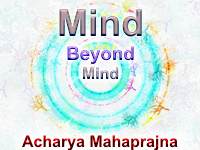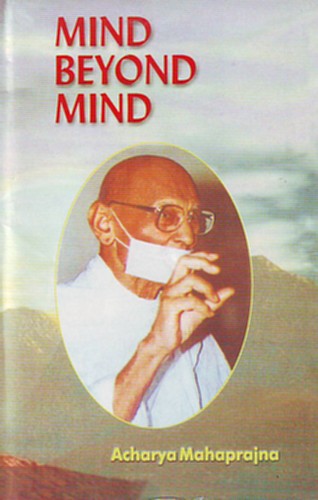
The world we live in appears to us sometimes as a unity and at other times as a medley of discordant elements. As a unity it inspires in us a sense of self-certainty and self-assurance. As a diversity it confuses us and creates philosophical doubts and we become curious to know the causes of things. An example of this kind of enquiry is provided by a dialogue between Sramana Kesi, Head of the Parsva sect of the Jain religion and Ganadhara Gautama, one of the apostles of Mahavira. Followed by their own ascetic disciples the two met at Sravasti. Their followers were struck by the diversity in the ascetic outfit and ways of religious life of the two sects. The Parsva monks put on dresses of various colours, whereas the Ganadhara Gautama's monks were uniformly dressed in white robes. Parsva had prescribed four vows of religious conduct, whereas Mahavira had prescribed five. Both the sects became curious to know why it was so. The Heads of the two sects could read the minds of their followers and arranged to meet each other in the presence of the latter. In the meeting Sramana Kesi asked Gautama: 'Our sects aim at achieving a common goal. How then is it that Parsva prescribed four vows and Mahavira five? Why is it that there is difference between the ascetic outfit and ways of life of the two? You are a wise man and, I think, you can explain the reason of this difference.' Gautama replied: 'If you want to understand the truth about Dharma, try to look into it with Panna (insight). Try to understand the essence rather than the form of Dharma. It does not consist in the observance of four or five vows. It exists in deep spiritual experiences in which there is no diversity but only unity. The essence of Dharma lies in these experiences.'
The aim of Preksha Dhyana (perceptive meditation) is to sink deep into spiritual experiences. It is in them that we can comprehend truth. It is an attempt to see the truth of Being directly.
There are two ways of comprehending truth: reasoning and Darsana (intuition). We are quite familiar with reasoning, but we do not know insight. We do not know how to see. Thinking and reasoning belong to a lower plane, whereas Darsana operates on a higher level. The former do not give us the strength of conviction, which the latter imparts. The former command only a limited area of enquiry and are, therefore, not competent to comprehend the nature of reality. Darsana, on the other hand, begins where reasoning ends. The two cannot go together. You will have to abandon the former in order to acquire the latter. They pursue separate ends. Darsana can be acquired by spiritual exertion and is indispensable in sadhana (spiritual exertion). It is the only means of seeing truth directly.
If Darsana means seeing, what are we to see? How are we to see and why. 'The answer to the question as to what we are to see is a very simple answer. See with the eyes and see whatever comes before you. You need not be told to see this or not to see that. You may see any and every thing you like to. When you really mean to see, you do not raise the question as to what you are to see. Let me once more say that you should see with your eyes and see whatever comes before you. For example, you may see a physical object. But you should also understand that in the first instance you will see only a gross figure or the bare outlines of the figure. Every object you see has two aspects: form and essence. There is no object in the world, which does not possess these two aspects. There can be no form without an essence and no essence without a form. The form is a modification of the essence, which lies at its root. You cannot deny the essence of either. Every fruit has a shell as well as a kernel. You should see both. In other words, you should see both within and without. Look at the object and also look into it. First you should see the gross form and then the essence within it. What you will see in the first glance is not the whole of the object. An object is much more than what it appears at one time. You should also see the subtle essence of the object.
Take an example. Here is a pencil in my hand. See it. The first thing, which has struck you, is the gross form of the pencil. Now, have a closer look at it. After a little observation, you will find the gross form of the pencil gradually disappearing. You will see something entirely new appearing in your vision. A prolonged observation will reveal to you a surprising succession of the modifications of the pencil If you continued seeing, you will come to see the colour of the pencil and then some letters impressed upon it. You could not have seen the colour and the letters in your first glance on the pencil. They have emerged in your vision only gradually. A tiny object like the pencil may have innumerable modifications. You cannot see them in a single moment all of a sudden. The pencil hides within itself immense potential to assume a succession of modifications in the course of a prolonged concentration of the eyes and the mind on it. It may even cease to be the thing you saw at first sight and appear to be an entirely new thing. In other words, the truth of the pencil manifests itself through the changing forms it assumes, one after another. The pencil becomes modified.
You may see your breath also. Watch it and try to feel the vibrations it produces. Try to feel its depth. Try to measure your respiration. Try to locate the point at which breathing takes a turn and where inhaling changes into exhaling. Try to watch the entire process of breathing. Try to watch the lightness and heaviness of your breath and also whether it is fast or slow. You will come to see the various modifications of your breath also.
You may see your own body. An immense wealth of material lies within it to be seen and watched. It is a very highly complex organism and possesses many delicate mechanisms. In spite of all the progress we have made in the field of technology, we cannot construct the parts it is made of. The human brain contains millions and millions of cells. It has centres connected with the sense organs. It has recesses in which emotions are continuously seething and surging. Predispositions, accumulated effects of past experiences and psychosomatic drives agitate it ceaselessly. You may see all these. You may fix your eyes at the end point of your nose or on any other part of your body and you will come across innumerable secrets about it which will capture your imagination. Then there are glands and nerve plexuses in your body. They are organically connected with the practice of concentration and meditation. You may go on seeing and observing them one after another and there will be no end to your seeing.
Let us pause here for a moment. Seeing is not an isolated act It produces effects. When you see an object for a long time your mind becomes concentrated on it and concentration ultimately leads to meditation. If you try to concentrate your mind on the Ajna Cakra situated in your brain, your mind will be centred on it. This Cakra attracts the mind. Every centre of the human body has the power to attract the mind towards itself. This is the effect of seeing.
There are many glands and plexuses in the body. They were called by the name Cakra in ancient Yoga. The Japanese Judo Buddhists call them Kyushos. It is interesting to note that the ancient experts in the discipline of Yoga, the Japanese Judo Buddhists and modern anatomy and physiology have studied them, their shapes and sizes and their functions and have come to almost the same conclusions about them and their operations.
| Kyushos | Glands and plexuses | Yoga Cakras |
| Tendo | Pineal gland | Sahasrara Cakra |
| Uto | Pituitary gland | Ajna Cakra |
| Hichu | Thyroid gland | Visuddhi Cakra |
| Kyototsu | Thymus gland | Anahata Cakra |
| Suigetsu | Scalar plexus | Manipura Cakra |
| Myojo | Adrinal gland | Svadhisthana Cakra |
| Tsurigane | Pelvic plexus | Muladhara Cakra |
You have to locate all these in your contemplation. The question as to what we are to see thus becomes meaningless. The human body is a vast field for observation and you may go on seeing it endlessly.
In the same way the world you live in provides innumerable objects to see. Every thing it contains deserves to be seen and understood. There is nothing loathsome in it as some ascetics have thought. Things, which we are accustomed to discard as detestable, are embodiments of truth.
The next question is: how are we to see? It is a very important question. The simplest answer to this question is: see with your eyes. But in order that you may see the nature of things you have to fulfil certain conditions, otherwise you will not be able to arrive at the right kind of perception. The first condition is an objective attitude of mind free from all kinds of predispositions prejudices and likes and dislikes. Our subjective attitude colours our perceptions and distorts our vision. It does not allow us to see things as they are. Moreover, the values we attach to things are based on subjective factors like our likes and dislikes. We cannot understand the reality of things unless we see them with a dispossessed mind: That is the answer to the question as to how we are to see.
We come in contact with reality through the sense organs and the mind. They impose limitations on our consciousness. They are the mediums through which consciousness has to function. In a state of free consciousness you may adopt any medium you like and the medium will not impose any limitation on it. Only a clouded consciousness becomes subject to the limitations imposed upon it by the sense organs and the mind. A free consciousness, even when it chooses a medium, does not become bound by it. The eyes and the mind are mediums of perception. You may use your eyes if you want to see gross things. You may use your mind if you want to see subtle things. While perceiving subtle things you may or may not keep your eyes open. The act of mental perception will not be affected in either case. Seeing things with the eyes wide open for a long time is called Animesa Darsana. It is called Trataka in the Tantras and Hatha Yoga. It means gazing at a particular point or object for a long time. Acharya Mahaprajna
Acharya Mahaprajna

